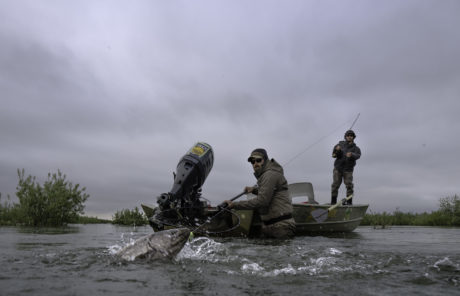
There is nothing more exciting to me at this point in my life than swinging flies to chrome bright Chinooks within a stone’s throw of the salt. Chinook are some of the finest anadromous quarry to be found in our west coast waters. They are the largest of the pacific salmon and have an attitude to match their length and girth. The runs are deep and powerful and often the angler is as wore out as the fish by the end of the encounter. Their horsepower is simply unmatched by many other species susceptible to swung fly tactics. This is a brief bit of insight to help you connect with more of these giant chromers.
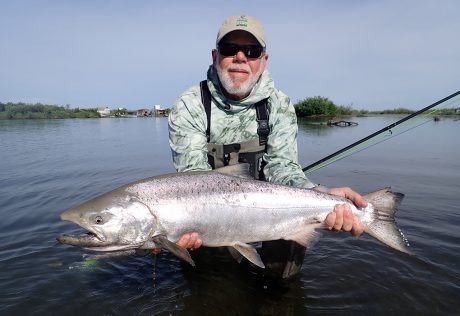
1. Have appropriate tackle.
Chinook salmon are incredibly powerful critters. When they are in their athletic prime dressed in sea lice they are truly a force to be reckoned with. Your standard 13’ 7wt steelhead stick and click and pawl reels are best left at home if you enjoy them in functional working order. A minimum of a stout 8wt with a smooth, powerful drag reel is best. If you have a 9 or 10 wt the odds tip further in your favor. My preferred rod is a 9120-4 Sage X paired with either a hatch finatic series or Loop Classic reel loaded with at least 250 yards of 50lb gel spun backing. I generally use monofilament shooting line and 50lb Froghair has proven reliable. A 20lb leader and 1 or 1/0 hooks are recommended. I have used both Gamakatsu and Owner Octopus hooks with good success. For lines that brings us to our next topic: depth.
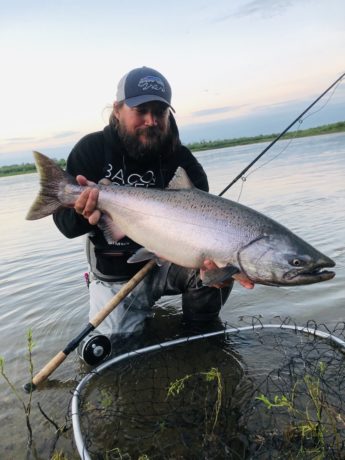
2. Depth, working the column from the top down
When targeting Chinooks many people’s natural inclination is to fish as deeply as possible in the deepest water possible. While there is no denying that a chunk of cured skien in a baitloop fished under a float can rule the day, such pieces of water are often unsuited for effective consistent fly fishing. More often than not the Chinook that will grab a swung fly is a suspended fish laying in 4-8’ depth along heavy current. The key word is suspended.
Chinook don’t always gravitate towards the deepest, slowest water possible until angling pressure, human or boat traffic, or tire from continuous travel has forced them to do so. The traveling fish that is fresh from the sea and relatively undisturbed is much more likely to hold in the afore-mentioned 4-8’ water. When they are traveling and suspended the most counterproductive thing you can do is fish too deep presenting the fly below them. If they can’t see your fly they can’t eat it. Eye level or slightly above seems most productive. Many Chinooks this past summer season took the fly within the first 1-5 seconds of it entering the water. A few even boiled on chugged waking flies. One fish even came out from underneath the shadow of my parked boat to ambush a fly as my angler was reaching to grab the leader after reeling up at the bottom of the run.
A floating Skagit head and a T-14 MOW or iMOW tip are the most versatile system when used correctly. When working the water column from the top down it is best to start with a 5×5 tip and finish with a full 12.5’ t-14. If you are fishing with multiple people, have each angler fishing a different MOW tip to effectively cover all depths that fish could be traveling through. If one type of tip is a clear standout winner, switch to it, and reap the benefits.
If you feel the need to go deeper multi density lines such as Rio’s Skagit Max game changer or Airflo’s F.I.S.T. lines paired with 10 or 12.5’ MOW tips can better your odds. It should be noted that the full sink-tip should be used. If a 5×5 MOW were to be used on a F.I.S.T. the rear floating portion of the M.O.W. would be fighting the sink three end of the F.I.S.T. it connects to. This can cause the line to lay out unpredictably and because of it, present the fly unpredictably. Always make sure your line system gets progressively heavier toward the fly end for best results.
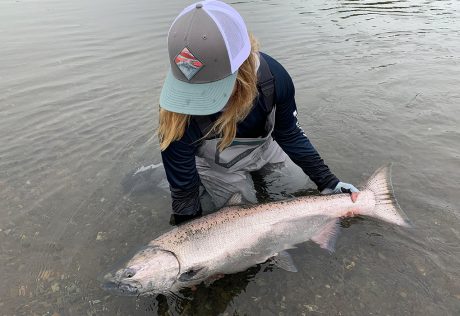
3. Be patient and learn your tides
Tidal activity is highly influential on coastal salmon fishing. It dictates their travel and timing and understanding your tides can help you be in the right place at the right time as consistently as possible.
Tides can also affect river height and flow closer to the ocean. Depending on the tide, the same piece of water could be an almost non flowing lake, a shallow ripping torrent or just right. The best way to learn the tide’s effect on your river is to simply go investigate and see how your intended water behaves. Not only does the tide affect how well the water will fish, it also dictates how many fish will be in that said water. High tide is always a good bet. The more dramatic the change in height the better the push of fish that come in. An outgoing tide can provide some action as well but from my experience it’s not nearly as good as high tide.
The tide will bring the fish to you so it’s generally best to find a piece of water and stick with it. There is a great saying that you hunt for steelhead but wait for kings. Have patience and wait for your quarry. Your fish will inevitably swim past you at some point and it’s best to leave your fly in the water to intercept him.
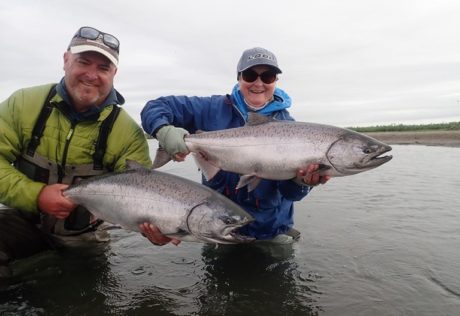
4. Fly selection
Chinook flies come in all shapes and sizes much like steelhead flies. It is a pretty daunting task to choose chinook fly out of the many hundreds of great ones out there. How big? What color? How heavy? These are all appropriate questions, but I think the most important question is, where are your potential flies going to be fished.
The location matters a great deal when selecting flies. How far from the ocean you are fishing plays a large role in fly selection? Generally, the closer you are to the ocean the more aggressive the fish will be. As they come in on a fresh tide, they are very similar to steelhead and display a tendency to take flies that are reminiscent of their ocean prey items. Shrimp, squid, and baitfish are all great choices. Many of the modern intruder style flies incorporate aspects of these prey items in their design. Good movement and life like appearance in the water are always productive. More static patterns such as Clouser Minnows and Decievers can take fish as well if the rod is used to give action to the fly, or by stripping the fly while itis swinging.
The further upriver a chinook travels the more this reminiscent feeding response fades and the more they strike out of aggression. In this scenario a brightly colored or excessively flashy fly with ample movement such as a Prom Dress or Marabou Tube Spey can be relied on if fished well. Often times upriver Chinooks require heavier flies because all of the human traffic they have encountered has driven them into deeper holding water than when they first entered the system. They are often not as apt to move to the fly after they have been subjected to a lot of angling traffic. Because of this, presenting a fly directly in their personal space to trigger a territorial, or fight or flight response is key.
In all cases no matter if you are upriver or in tidewater, water clarity is a large deciding factor in fly selection. The clearer the water the smaller the fly. In low clear water Chinooks can be very shy toward larger flies despite their tenacious reputation. A good rule of thumb is: fish a fly a half inch to an inch larger than you would choose for steelhead under the same water conditions. If you have the ideal 2-4’ of visibility a fly in the 3-4” range is perfect. If you have good visibility more than 6-7’ a very small sparsely dressed fly in the 1-2.5” range can do well. In the sun it pays to downsize the fly. The increased light levels improve visibility and it has the same effect as clearer water on fish and they are not as apt to grab larger flies.
As far as color goes there isn’t really a color a king won’t eat nor is there a magic color they all eat. Bright fluorescent colors such as chartreuses and pinks are a definite standout in coastal waters with darker colors such as blacks, blues, or purple producing upriver. These however are just general guidelines and a biter in a biting mood will most likely strike at the first well-presented item regardless of color. As my good pal Hawkeye Hawkins likes to say “The dog doesn’t care what color the ball is, just throw the ball”
The worst thing you can do when selecting king flies is just choose the largest heaviest most obnoxious fly you can find. That won’t do any good other than maybe spook a few fish and send you to a chiropractor. Flies that are easy to cast in a wide variety of weights sizes and colors are key. My typical approach is to bring a large selection with me and then once I’ve arrived at my fishing destination, I carefully consider some of the environmental factors mentioned and narrow my selection further to a few flies and then I fish. I don’t second guess. I don’t get fly anxiety; I trust the fly and swim it. It really stings to watch a big Chinook roll as he swims past you in the midst of clipping off one equally good fly for another.
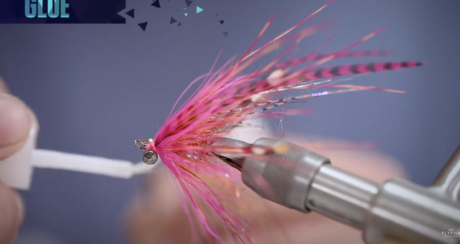
5. Safely fighting and landing Chinooks
So you’ve put in the hours and time learning your water, honing your presentation, and now your line comes tight with a firmly hooked 20lb Chinook. What now?
Generally, the first thing most of them will do is run. Sometimes they go down sometimes they go up. Either way the best course of action is hang on and let them do it. Don’t try and stop them on the first run. They can pull back a lot harder than you can pull on them. When they’re supercharged within 30 seconds of being hooked putting the wood to them is a great way to either straighten your hook or piss them off back into the Pacific. Keep your cool and let them do their thing. A great way to think of it is let the fish fight itself and just orchestrate and guide the whole process. The fish will generally head in the opposite direction as the tension he feels from you. Work your angles and pull in the direct opposite direction you want your fish to go keeping your rod low with steady pressure. Be aware of any snags or woody debris and try to keep them away from it if possible but if your fish beelines for it, there’s not a whole lot you can do other than hope.
The one thing that will occasionally turn a hot king headed downstream is a complete act of faith that sometimes works and should probably only be done in a circumstance where it’s make the move or lose the fish. You can turn your drag completely off, relieve almost all pressure, and let you reel empty downstream. In most cases if the fish is hooked well, the fish slows his downstream progression when he feels the ease of tension. The line is swept downstream below the fish and begins to pull from downstream. As mentioned earlier fish usually travel in the opposite direction as the tension they feel when hooked. This causes them to slowly swim back upstream. Keep your tip to the inside to maintain a downstream belly in your line and slowly reel them back up until you’re tight to the fish again, then carry on.
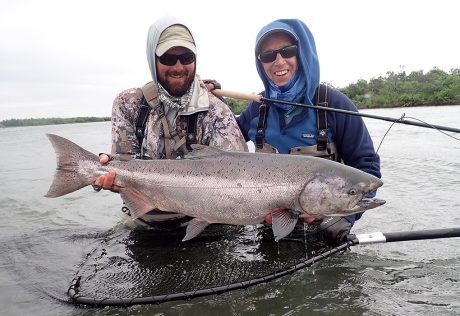
A large net is highly recommended as well as maybe a fishing partner to help you with the process. These aren’t 7-10lb steelhead. They’re giant powerful fish with broad bodies that are difficult to get ahold of and control. Tailing them is always an option as well but I prefer a net if possible. Still to this day I have never successfully tailed a chinook over 8lbs while fishing solo. I personally think when it comes to chinook that a net minimizes the possibility of anything going awry and possible injury to the fish or yourself. A large rubber coated mesh net that’s quite deep is a great choice. Depth minimizes the possibility of the fish flipping back out of the bag as well as the rubber coated mesh is much easier on their bodies for catch and release. When releasing a Chinook, they don’t often scoot right off like a steelhead or some of the other pacific salmon species such as Chums or Coho. Once they’re in your hands they become very calm and almost lethargic in their captivity. Quite a few of them, once fully recovered need a bit of a shove off to make them aware of their liberation at which point they hit the gas pedal often times giving you a nice shower on their way back to the depth. Then maybe take time-out for celebration and repeat.
This is probably a lot to take in all at once so return and refresh yourself as often as necessary.
Good fishing guide, enjoyed reading it.
We are very glad you liked the article Sujan, thanks for the reply! Tightlines